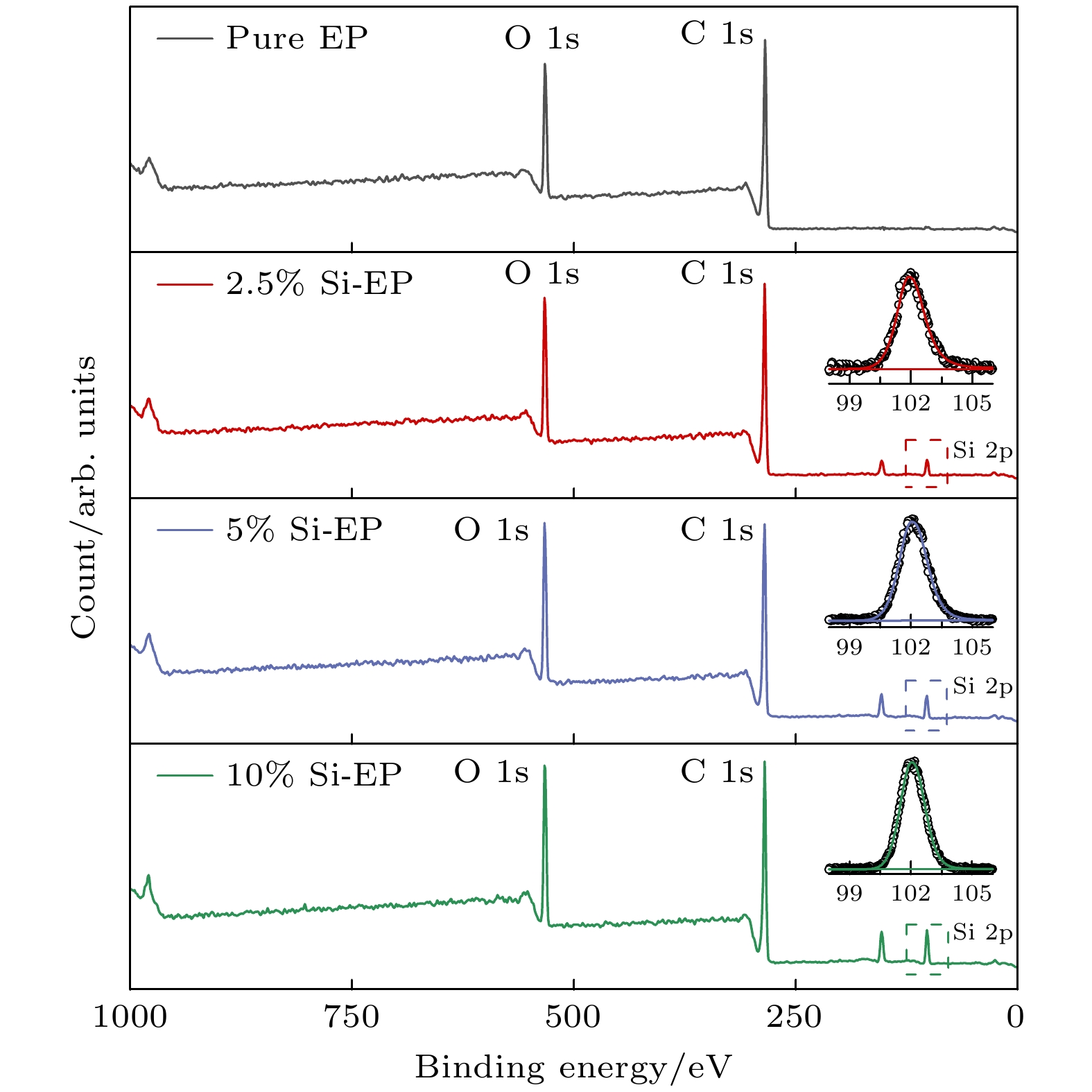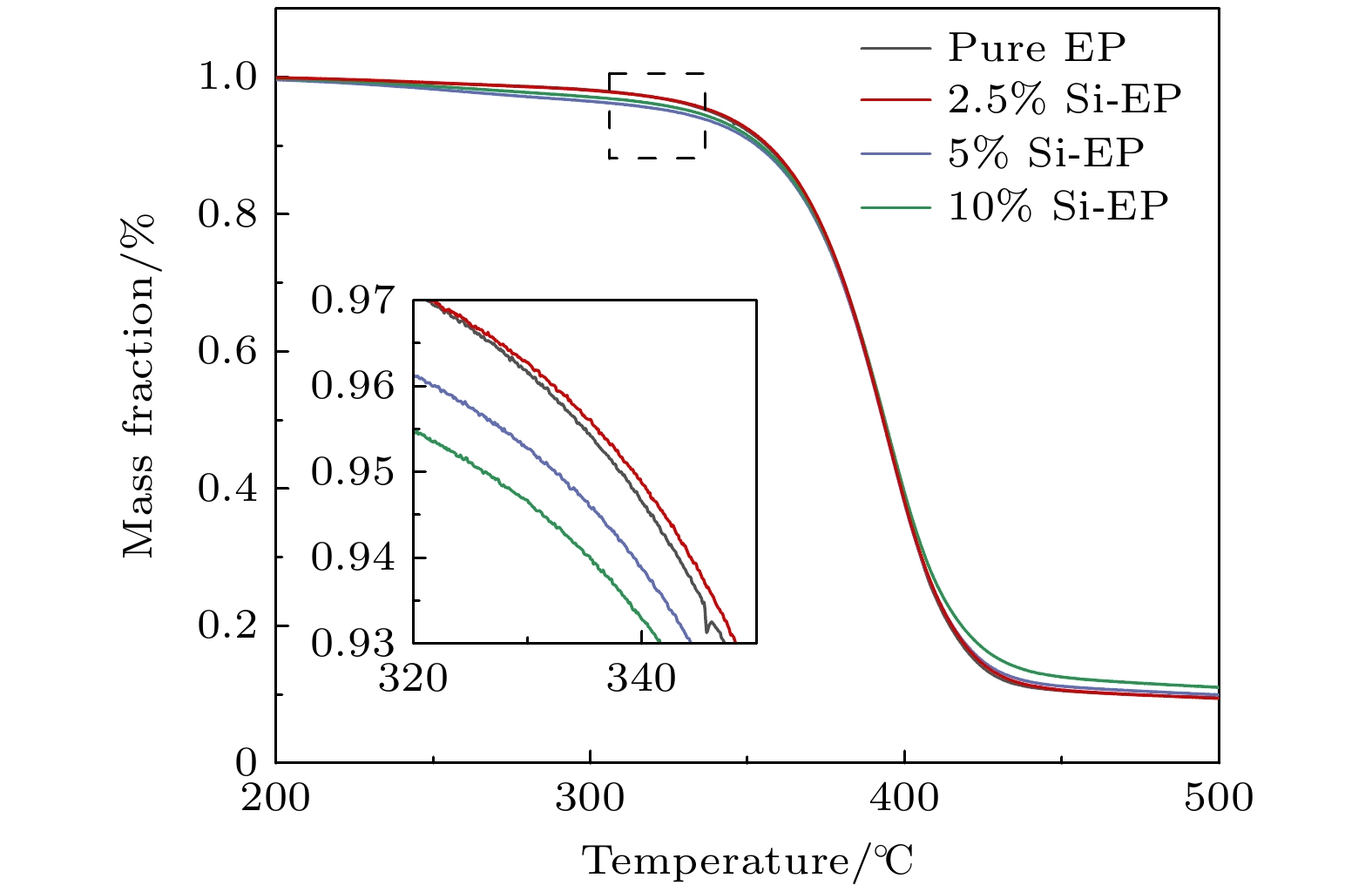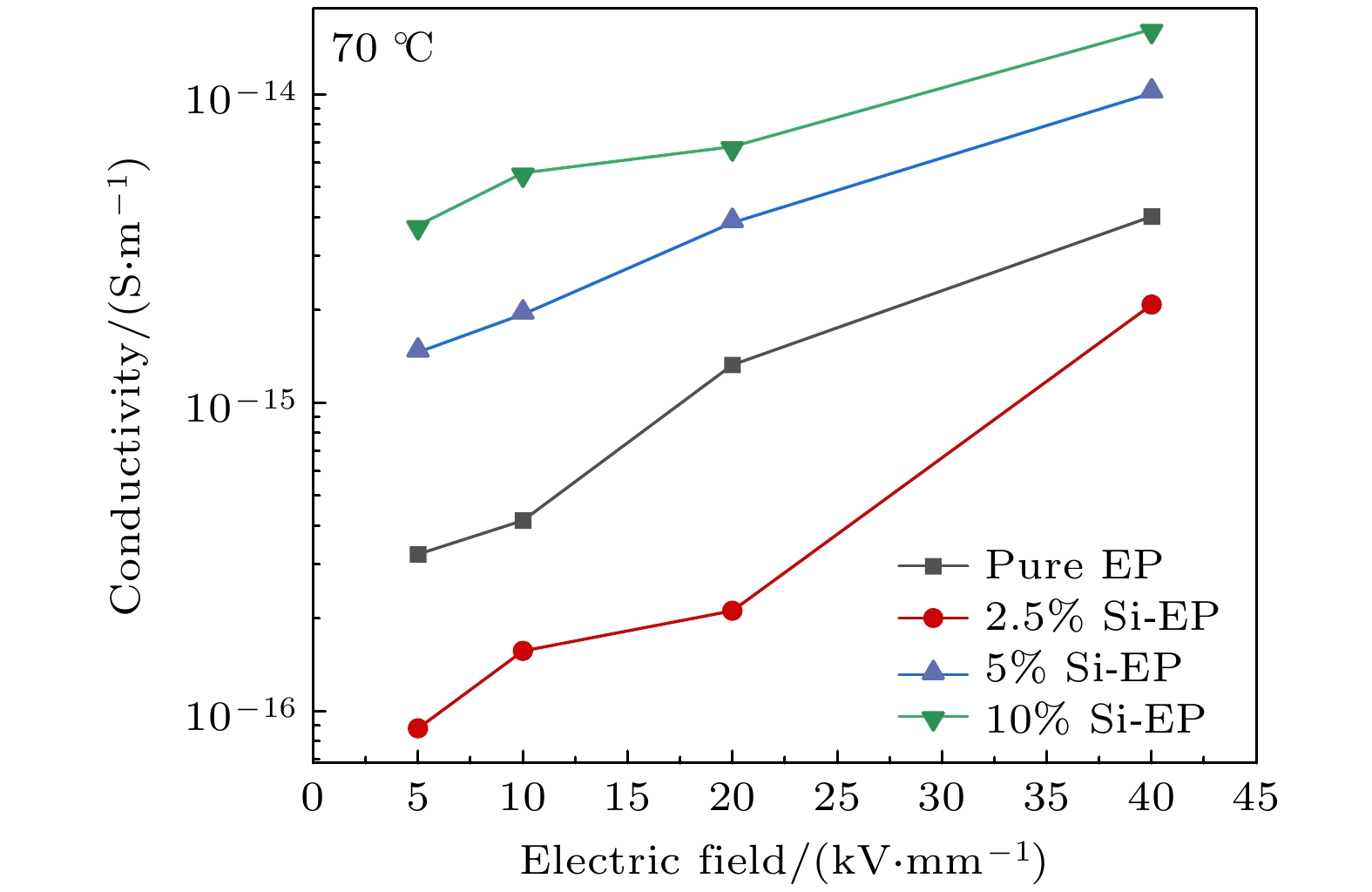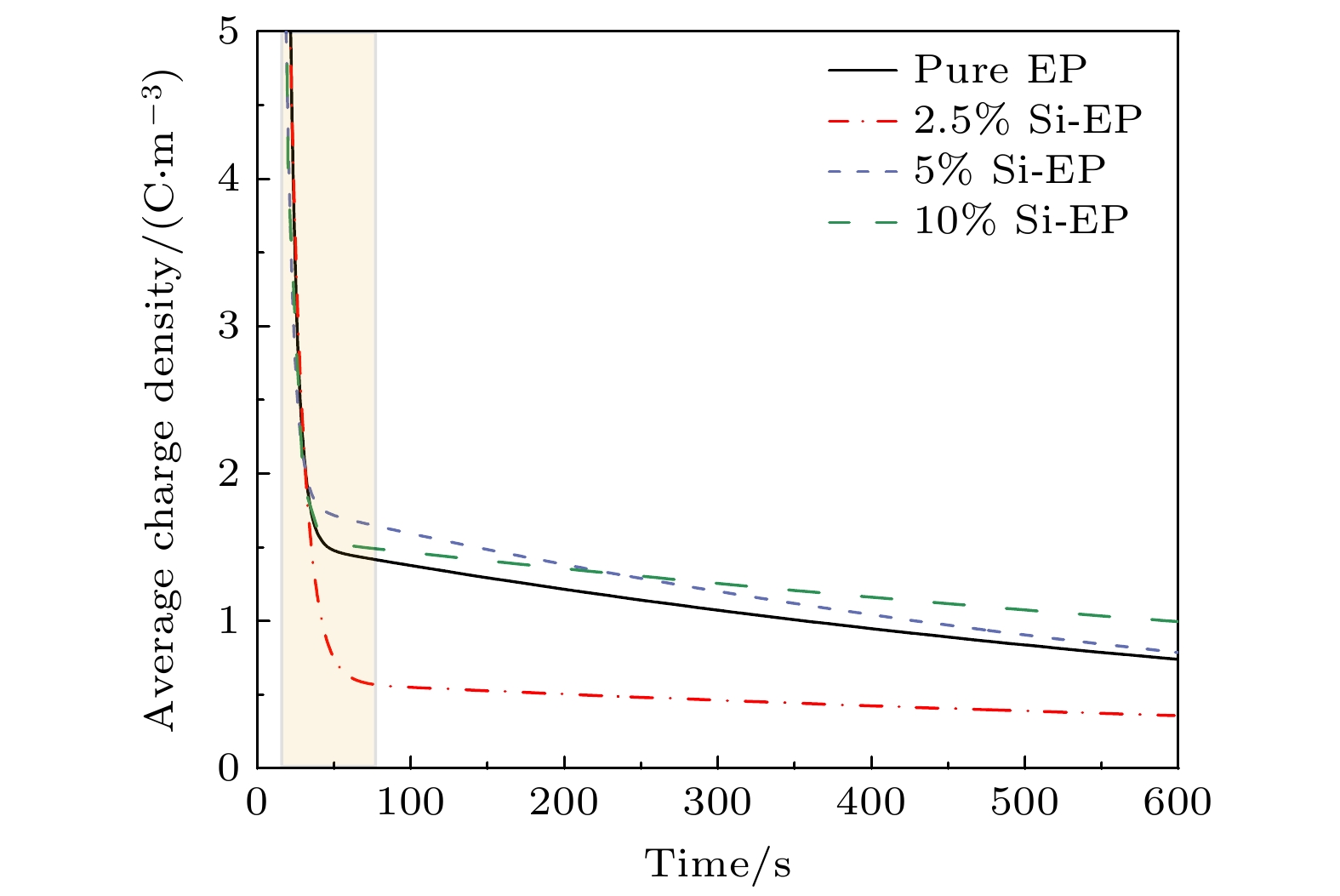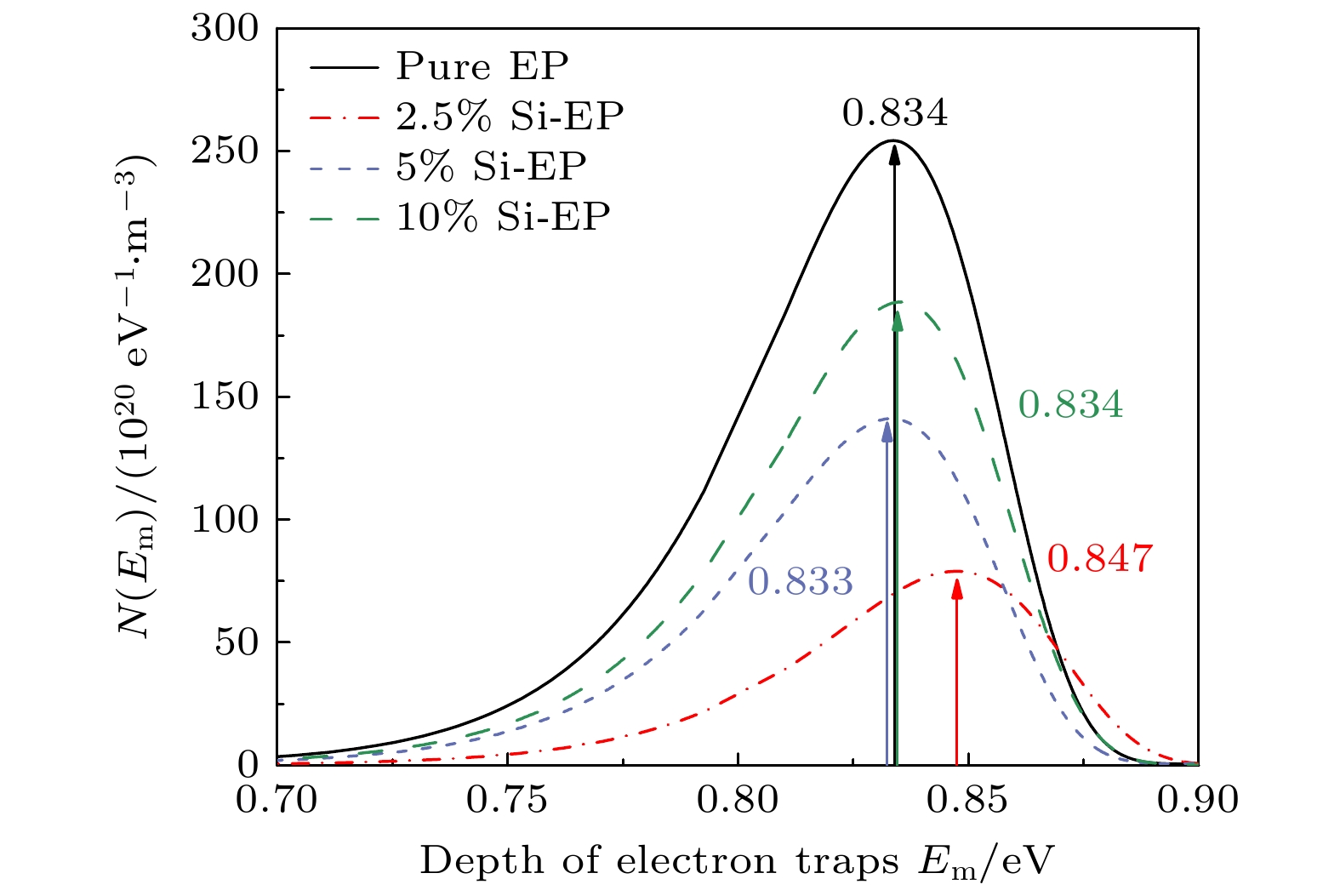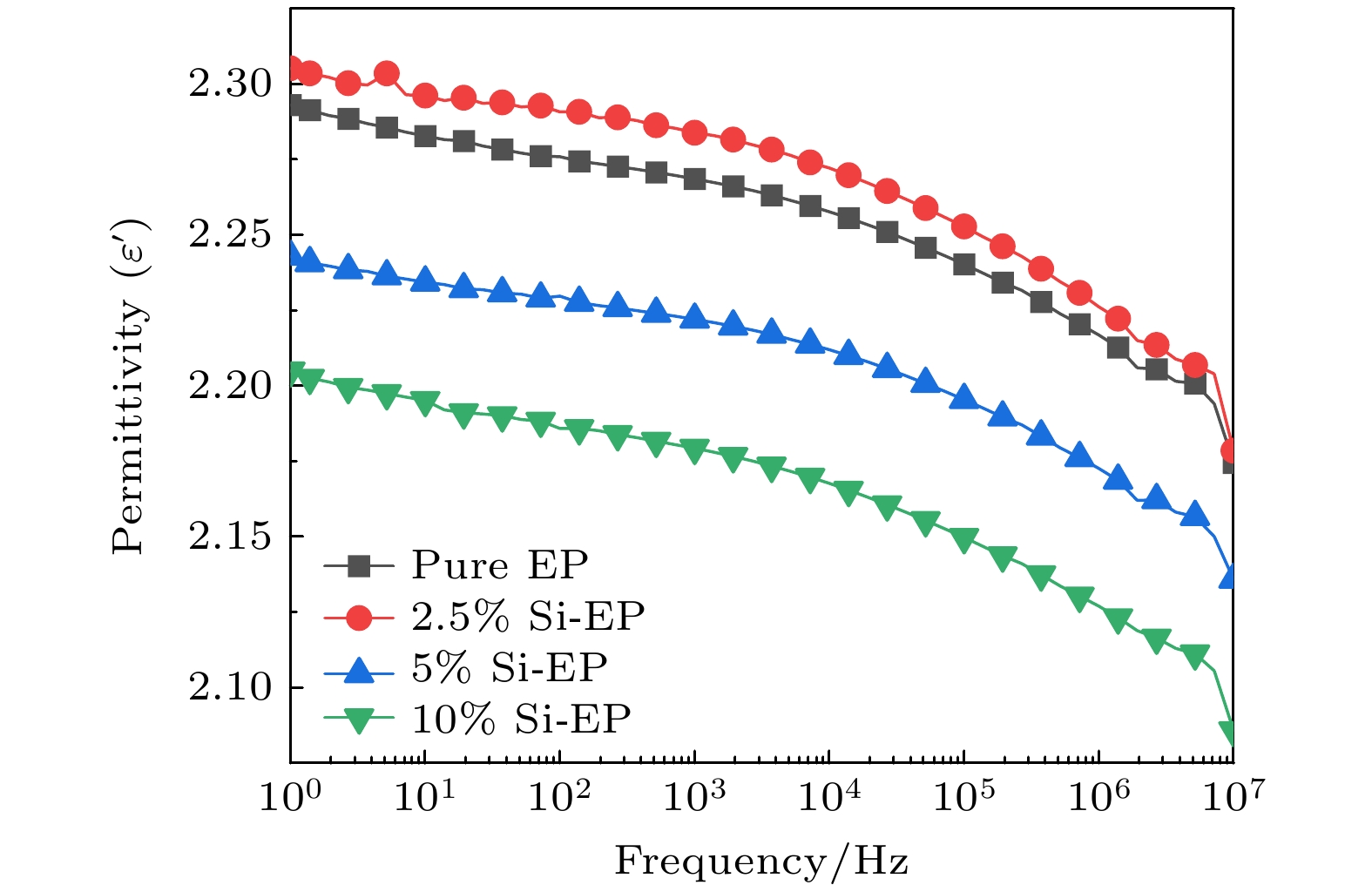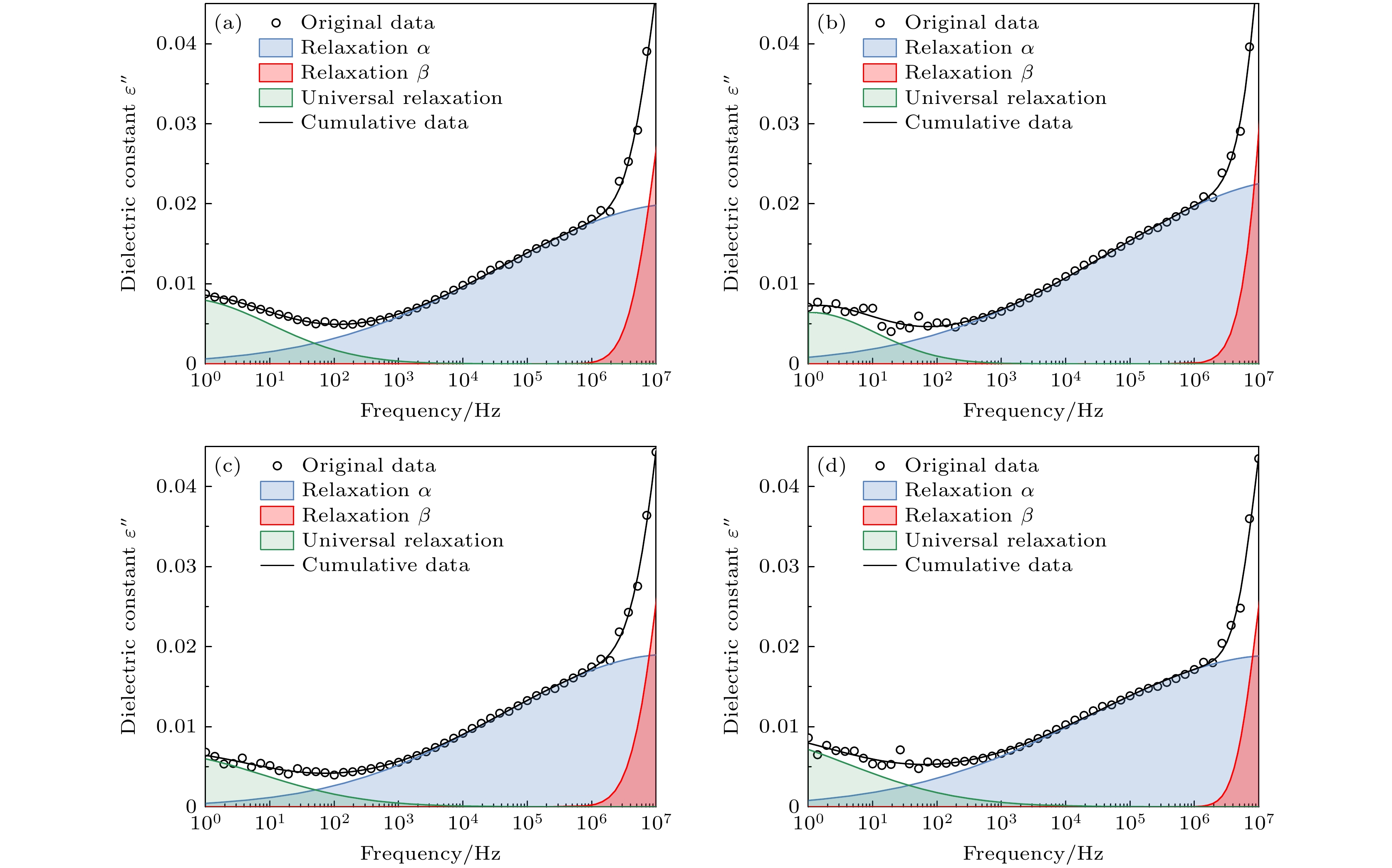-
电子器件向着大功率、小型化方向发展对环氧树脂电子封装材料的高温电学性能提出了更高的要求. 本研究采用环氧基封端苯基三硅氧烷(ETS)作为功能单体, 通过交联反应将Si—O键引入到双酚A环氧树脂中, 系统研究了ETS对环氧树脂复合材料的结构以及高温电学特性的影响及调控作用. 实验结果表明, 随着ETS含量的增大, 环氧树脂复合材料的交联度逐渐降低. 当ETS添加质量分数为2.5%时, 复合材料的玻璃化转变温度及热稳定性得到了提升, 且呈现最优综合电学性能, 在70 ℃下, 该复合材料电导率大幅下降, 空间电荷积聚程度得到明显改善, 陷阱深度加深, 介电损耗降低, 击穿强度提升至74.2 kV/mm. 随着ETS含量的逐步增大, 环氧复合材料的电学性能呈现先增强后减弱的非线性变化规律, 这种浓度依赖性行为与纳米填料改性体系具有相似的特性演变特征. 本文提出通过对硅氧烷与环氧交联后构成的微观交联网络拓扑结构演变来解释ETS对环氧树脂高温电学性能的影响. 本研究为开发硅氧烷改性高性能环氧树脂电子封装材料提供了重要的理论依据以及设计策略.The ongoing trend toward high-power and miniaturized electronic devices has raised increasingly stringent requirements for the high-temperature electrical properties of epoxy encapsulating materials. In this study, epoxy-terminated phenyltrisiloxane (ETS) is used as a functional monomer to incorporate Si-O bonds into bisphenol-A epoxy resin through crosslinking reactions, thereby systematically investigating the influence and modulation effects of ETS on the structure and high-temperature electrical characteristics of epoxy composites. Gel content measurements indicate that as the concentration of ETS increases, the gel content of the epoxy resin composite decreases accordingly, suggesting that higher ETS content reduces the crosslinking density of the epoxy network. Experimental test results demonstrate that compared with pure epoxy resin, the composite with 2.5% ETS exhibits superior performance: the glass transition temperature increases to 129 ℃ with thermal decomposition temperature rising, while showing optimal high-temperature (70 ℃) electrical properties including significantly reduced conductivity, markedly suppressed space charge accumulation, deepened trap energy level (from 0.834 eV to 0.847 eV), reduced dielectric loss (0.005 at 50 Hz), and improved breakdown strength (74.2 kV/mm). Notably, as the ETS content increases, the electrical properties of epoxy composite follow a non-monotonic concentration dependence, initially enhancing then deteriorating, exhibiting evolutionary characteristics similar to those of nanoparticle-modified systems. Herein, a competitive mechanism between the epoxy network structure and intrinsic properties of ETS is proposed to explain this phenomenon: at low concentrations, the original C—C network dominates, where the intrinsic properties of ETS are constrained by the host matrix, leading to improved thermal stability. Simultaneously, the bandgap difference between ETS and DGEBA establishes charge barriers that can enhance insulation performance. However, at higher concentrations, the reduced crosslinking density and increased free volume caused by reactivity and structural mismatch between ETS and DGEBA ultimately lead to performance degradation. This study offers crucial theoretical insights into and produces the design strategies for developing high-performance siloxane-modified epoxy encapsulants.
-
Keywords:
- epoxy resin /
- siloxane /
- crosslinked network /
- high-temperature insulation
[1] 任俊文, 姜国庆, 陈志杰, 魏华超, 赵莉华, 贾申利 2024 物理学报 73 027703
 Google Scholar
Google Scholar
Ren J W, Jiang G Q, Chen Z J, Wei H C, Zhao L H, Jia S L 2024 Acta Phys. Sin. 73 027703
 Google Scholar
Google Scholar
[2] Geng H R, Zhao L, Deng J, Chen J R, Fan Y H, Zhao Q Y, Gui H X, Liao J H, Zhao Y F, Qian Y X, Wang G Z 2025 Compos. Sci. Technol. 261 110993
 Google Scholar
Google Scholar
[3] You Z Y, Weng L, Guan L Z, Zhang X R, Wu Z J, Chen H, Zhao W 2025 High Volt. 10 219
 Google Scholar
Google Scholar
[4] Jiang C W, Hao C X, Zi C F, Li J, Liu W J, Bian Y M, Sun F Y, Xu Y Q, Yan Y X, Wang L Y, Su F Y, Tian Y Q 2025 Compos. Sci. Technol. 265 111135
 Google Scholar
Google Scholar
[5] Xia G W, Xie J, Song Y Z, Duan Q J, Zhong Y Y, Xie Q 2025 Compos. Sci. Technol. 261 111019
 Google Scholar
Google Scholar
[6] Yang X, Huang W J, Dong H, Zha J W 2025 Adv. Mater. 37 2500472
 Google Scholar
Google Scholar
[7] Maes S, Badi N, Winne J M, Du Prez F E 2025 Nat. Rev. Chem. 9 144
 Google Scholar
Google Scholar
[8] Yang K R, Dai J Y, Zhao W W, Wang S P, Liu X Q 2024 Compos. part B: Eng. 284 111728
 Google Scholar
Google Scholar
[9] Zhou Y, LaChance A M, Wang Q, Gao Y F, Zhou J R, Huang B D, Shen K Y, Hou Z L, Lei T, Wang N Z, Zuo Z, Liu S, Dissado L A, Shao T, Liang X D, Cao Y, Sun L Y, Wu C, 2025 J. Mater. Chem. A 13 12926
 Google Scholar
Google Scholar
[10] Wang Z Y, Sun X, Wang Y, Liu J D, Zhang C, Zhao Z B, Du X Y 2023 Ceram. Int. 49 2871
 Google Scholar
Google Scholar
[11] 黄家良, 高筱然, 郭亮, 宋思宇, 朱杰, 方志 2025 高电压技术 51 2476
 Google Scholar
Google Scholar
Huang J L, Gao X R, Guo L, Song S Y, Zhu J, Fang Z 2025 High Volt. Eng. 51 2476
 Google Scholar
Google Scholar
[12] 邱甲云, 安秋凤, 史书源, 卢攀 2023 绝缘材料 56 1
 Google Scholar
Google Scholar
Qiu J Y, An Q F, Shi S Y, Lu P 2023 Insul. Mater. 56 1
 Google Scholar
Google Scholar
[13] Liu Y P, Li L, Liu H C, Zhang M J, Liu A J, Liu L, Tang L, Wang G L, Zhou S S 2020 Compos. Sci. Technol. 200 108418
 Google Scholar
Google Scholar
[14] 贺涛, 刘文凤, 冀运东 2024 热固性树脂 39 1
 Google Scholar
Google Scholar
He T, Liu W F, Ji Y D 2024 Thermoset. Resin 39 1
 Google Scholar
Google Scholar
[15] Jin B H, Jang J, Kang D J, Yoon S, Im H G 2022 Compos. Sci. Technol. 224 109456
 Google Scholar
Google Scholar
[16] Wang C Z, Li S X, Yuan Y, Ji Y D, Cao D F 2024 Polymer 308 127368
 Google Scholar
Google Scholar
[17] Zhang Y, Shi Y X, Jin C, Wu C, Dong H, Qu Z R, Song Y J 2025 React. Funct. Polym. 207 106114
 Google Scholar
Google Scholar
[18] Singha S, Thomas M 2008 IEEE Trans. Dielect. Electr. Insul. 15 12
 Google Scholar
Google Scholar
[19] Ma Y N, Zhao Z H, Zheng Z R, Li J W, Li M H, Hu J 2024 Matter 7 4046
 Google Scholar
Google Scholar
[20] Gibbs G V, Wallace A F, Cox D F, Downs R T, Ross N L, Rosso K M 2009 Am. Mineral. 94 1085
 Google Scholar
Google Scholar
[21] Rüchardt C, Beckhaus H 1980 Angew. Chem. Int. Ed. Engl. 19 429
 Google Scholar
Google Scholar
[22] Sun B Z, Liang H L, Che D Y, Liu H P, Guo S 2019 RSC Adv. 9 9099
 Google Scholar
Google Scholar
[23] Liu Z Y, Wang H, Chen Y Z, Kang G D, Hua L, Feng J D 2022 Polymers 14 512
 Google Scholar
Google Scholar
[24] Yu M, Chen Z Y, Li J, Tan J H, Zhu X B 2023 Molecules 28 2826
 Google Scholar
Google Scholar
[25] Weinhold F, West R 2011 Organometallics 30 5815
 Google Scholar
Google Scholar
[26] Armstrong D A, Yu D, Rauk A 1996 Can. J. Chem. 74 1192
 Google Scholar
Google Scholar
[27] Smith K L, Black K M 1984 J. Vac. Sci. Technol. A 2 744
 Google Scholar
Google Scholar
[28] Berthomieu C, Hienerwadel R 2009 Photosynth. Res. 101 157
 Google Scholar
Google Scholar
[29] Nabedryk E, Andrianambinintsoa S, Berger G, Leonhard M, Mäntele W, Breton J 1990 Biochim. Biophys. Acta–Bioenerg. 1016 49
 Google Scholar
Google Scholar
[30] Yin K, Fan Q H, Li J, Rahman T U, Zhang T Y, Paramane A, Chen X R 2024 High Volt. 9 930
 Google Scholar
Google Scholar
[31] Kim M T 1997 Thin Solid Films 311 157
 Google Scholar
Google Scholar
[32] Oh T 2010 Phys. Status Solidi C 7 448
 Google Scholar
Google Scholar
[33] Cao G, Yan Y, Zou X M, Zhu R S, Ouyang F Y 2018 Spectral Anal. Rev. 06 12
 Google Scholar
Google Scholar
[34] Turchanin A, Käfer D, El-Desawy M, Wöll C, Witte G, Gölzhäuser A 2009 Langmuir 25 7342
 Google Scholar
Google Scholar
[35] Dai X Z, Rumi A, Cavallini A, Bak C L, Hao J, Liao R J, Wang H 2024 IEEE Trans. Dielect. Electr. Insul. 31 2290
 Google Scholar
Google Scholar
[36] Zhu Y W, Jiang Y H, Cao F H, Wang P J, Ke J X, Liu J, Nie Y J, Li G C, Wei Y H, Lu G H, Li S T 2025 J. Mater. Chem. C 13 11697
 Google Scholar
Google Scholar
[37] Simmons J G, Tam M C 1973 Phys. Rev. B 7 3706
 Google Scholar
Google Scholar
[38] Wang T Y, Mao J, Zhang B, Zhang G X, Dang Z M 2024 Nat. Rev. Electr. Eng. 1 516
 Google Scholar
Google Scholar
[39] Wu C, Liang X D, Dissado L A, Chalashkanov N M, Dodd S J, Gao Y F, Xu S 2018 Compos. Sci. Technol. 163 56
 Google Scholar
Google Scholar
[40] Fu J Y 2014 Philos. Mag. 94 1788
 Google Scholar
Google Scholar
[41] Wu K N, Sui H R, Ren Y R, Yang K, Zhao P, Ouyang B H, Li H, Zhang X, Ran L, Li J Y 2025 IEEE Trans. Dielect. Electr. Insul. 32 815
 Google Scholar
Google Scholar
[42] Wang Q L, Chen X R, Li J Y, Paramane A, Huang X F, Ren N 2024 IEEE Trans. Dielect. Electr. Insul. 31 1823
 Google Scholar
Google Scholar
[43] 高铭泽, 张沛红 2016 物理学报 65 247802
 Google Scholar
Google Scholar
Gao M Z, Zhang P H 2016 Acta Phys. Sin. 65 247802
 Google Scholar
Google Scholar
[44] Grabowsky S, Beckmann J, Luger P 2012 Aust. J. Chem. 65 785
 Google Scholar
Google Scholar
[45] Chen J, Zhou Y, Huang X Y, Yu C Y, Han D L, Wang A, Zhu Y K, Shi K M, Kang Q, Li P L, Jiang P K, Qian X S, Bao H, Li S T, Wu G N, Zhu X Y, Wang Q 2023 Nature 615 62
 Google Scholar
Google Scholar
-
图 4 (a)—(d) Pure EP, 2.5% Si-EP, 5% Si-EP和10% Si-EP的SEM照片; (e), (f) 2.5% Si-EP表面C, O, Si元素分布及含量; (g), (h) 10% Si-EP表面C, O, Si元素分布及含量
Fig. 4. (a)–(d) SEM of Pure EP, 2.5% Si-EP, 5% Si-EP and 10% Si-EP samples; (e), (f) distribution of C, O and Si elements and content on the surface of 2.5% Si-EP; (g), (h) distribution of C, O and Si elements and content on the surface of 10% Si-EP.
表 1 Pure EP, Si-EP韦布尔概率分布参数
Table 1. Weibull distribution parameters for Pure EP and Si-EP samples.
Pure EP 2.5% Si-EP 5% Si-EP 10% Si-EP β 68.3 74.2 72.6 67.2 σ 14.5 16.1 11.1 12.5 -
[1] 任俊文, 姜国庆, 陈志杰, 魏华超, 赵莉华, 贾申利 2024 物理学报 73 027703
 Google Scholar
Google Scholar
Ren J W, Jiang G Q, Chen Z J, Wei H C, Zhao L H, Jia S L 2024 Acta Phys. Sin. 73 027703
 Google Scholar
Google Scholar
[2] Geng H R, Zhao L, Deng J, Chen J R, Fan Y H, Zhao Q Y, Gui H X, Liao J H, Zhao Y F, Qian Y X, Wang G Z 2025 Compos. Sci. Technol. 261 110993
 Google Scholar
Google Scholar
[3] You Z Y, Weng L, Guan L Z, Zhang X R, Wu Z J, Chen H, Zhao W 2025 High Volt. 10 219
 Google Scholar
Google Scholar
[4] Jiang C W, Hao C X, Zi C F, Li J, Liu W J, Bian Y M, Sun F Y, Xu Y Q, Yan Y X, Wang L Y, Su F Y, Tian Y Q 2025 Compos. Sci. Technol. 265 111135
 Google Scholar
Google Scholar
[5] Xia G W, Xie J, Song Y Z, Duan Q J, Zhong Y Y, Xie Q 2025 Compos. Sci. Technol. 261 111019
 Google Scholar
Google Scholar
[6] Yang X, Huang W J, Dong H, Zha J W 2025 Adv. Mater. 37 2500472
 Google Scholar
Google Scholar
[7] Maes S, Badi N, Winne J M, Du Prez F E 2025 Nat. Rev. Chem. 9 144
 Google Scholar
Google Scholar
[8] Yang K R, Dai J Y, Zhao W W, Wang S P, Liu X Q 2024 Compos. part B: Eng. 284 111728
 Google Scholar
Google Scholar
[9] Zhou Y, LaChance A M, Wang Q, Gao Y F, Zhou J R, Huang B D, Shen K Y, Hou Z L, Lei T, Wang N Z, Zuo Z, Liu S, Dissado L A, Shao T, Liang X D, Cao Y, Sun L Y, Wu C, 2025 J. Mater. Chem. A 13 12926
 Google Scholar
Google Scholar
[10] Wang Z Y, Sun X, Wang Y, Liu J D, Zhang C, Zhao Z B, Du X Y 2023 Ceram. Int. 49 2871
 Google Scholar
Google Scholar
[11] 黄家良, 高筱然, 郭亮, 宋思宇, 朱杰, 方志 2025 高电压技术 51 2476
 Google Scholar
Google Scholar
Huang J L, Gao X R, Guo L, Song S Y, Zhu J, Fang Z 2025 High Volt. Eng. 51 2476
 Google Scholar
Google Scholar
[12] 邱甲云, 安秋凤, 史书源, 卢攀 2023 绝缘材料 56 1
 Google Scholar
Google Scholar
Qiu J Y, An Q F, Shi S Y, Lu P 2023 Insul. Mater. 56 1
 Google Scholar
Google Scholar
[13] Liu Y P, Li L, Liu H C, Zhang M J, Liu A J, Liu L, Tang L, Wang G L, Zhou S S 2020 Compos. Sci. Technol. 200 108418
 Google Scholar
Google Scholar
[14] 贺涛, 刘文凤, 冀运东 2024 热固性树脂 39 1
 Google Scholar
Google Scholar
He T, Liu W F, Ji Y D 2024 Thermoset. Resin 39 1
 Google Scholar
Google Scholar
[15] Jin B H, Jang J, Kang D J, Yoon S, Im H G 2022 Compos. Sci. Technol. 224 109456
 Google Scholar
Google Scholar
[16] Wang C Z, Li S X, Yuan Y, Ji Y D, Cao D F 2024 Polymer 308 127368
 Google Scholar
Google Scholar
[17] Zhang Y, Shi Y X, Jin C, Wu C, Dong H, Qu Z R, Song Y J 2025 React. Funct. Polym. 207 106114
 Google Scholar
Google Scholar
[18] Singha S, Thomas M 2008 IEEE Trans. Dielect. Electr. Insul. 15 12
 Google Scholar
Google Scholar
[19] Ma Y N, Zhao Z H, Zheng Z R, Li J W, Li M H, Hu J 2024 Matter 7 4046
 Google Scholar
Google Scholar
[20] Gibbs G V, Wallace A F, Cox D F, Downs R T, Ross N L, Rosso K M 2009 Am. Mineral. 94 1085
 Google Scholar
Google Scholar
[21] Rüchardt C, Beckhaus H 1980 Angew. Chem. Int. Ed. Engl. 19 429
 Google Scholar
Google Scholar
[22] Sun B Z, Liang H L, Che D Y, Liu H P, Guo S 2019 RSC Adv. 9 9099
 Google Scholar
Google Scholar
[23] Liu Z Y, Wang H, Chen Y Z, Kang G D, Hua L, Feng J D 2022 Polymers 14 512
 Google Scholar
Google Scholar
[24] Yu M, Chen Z Y, Li J, Tan J H, Zhu X B 2023 Molecules 28 2826
 Google Scholar
Google Scholar
[25] Weinhold F, West R 2011 Organometallics 30 5815
 Google Scholar
Google Scholar
[26] Armstrong D A, Yu D, Rauk A 1996 Can. J. Chem. 74 1192
 Google Scholar
Google Scholar
[27] Smith K L, Black K M 1984 J. Vac. Sci. Technol. A 2 744
 Google Scholar
Google Scholar
[28] Berthomieu C, Hienerwadel R 2009 Photosynth. Res. 101 157
 Google Scholar
Google Scholar
[29] Nabedryk E, Andrianambinintsoa S, Berger G, Leonhard M, Mäntele W, Breton J 1990 Biochim. Biophys. Acta–Bioenerg. 1016 49
 Google Scholar
Google Scholar
[30] Yin K, Fan Q H, Li J, Rahman T U, Zhang T Y, Paramane A, Chen X R 2024 High Volt. 9 930
 Google Scholar
Google Scholar
[31] Kim M T 1997 Thin Solid Films 311 157
 Google Scholar
Google Scholar
[32] Oh T 2010 Phys. Status Solidi C 7 448
 Google Scholar
Google Scholar
[33] Cao G, Yan Y, Zou X M, Zhu R S, Ouyang F Y 2018 Spectral Anal. Rev. 06 12
 Google Scholar
Google Scholar
[34] Turchanin A, Käfer D, El-Desawy M, Wöll C, Witte G, Gölzhäuser A 2009 Langmuir 25 7342
 Google Scholar
Google Scholar
[35] Dai X Z, Rumi A, Cavallini A, Bak C L, Hao J, Liao R J, Wang H 2024 IEEE Trans. Dielect. Electr. Insul. 31 2290
 Google Scholar
Google Scholar
[36] Zhu Y W, Jiang Y H, Cao F H, Wang P J, Ke J X, Liu J, Nie Y J, Li G C, Wei Y H, Lu G H, Li S T 2025 J. Mater. Chem. C 13 11697
 Google Scholar
Google Scholar
[37] Simmons J G, Tam M C 1973 Phys. Rev. B 7 3706
 Google Scholar
Google Scholar
[38] Wang T Y, Mao J, Zhang B, Zhang G X, Dang Z M 2024 Nat. Rev. Electr. Eng. 1 516
 Google Scholar
Google Scholar
[39] Wu C, Liang X D, Dissado L A, Chalashkanov N M, Dodd S J, Gao Y F, Xu S 2018 Compos. Sci. Technol. 163 56
 Google Scholar
Google Scholar
[40] Fu J Y 2014 Philos. Mag. 94 1788
 Google Scholar
Google Scholar
[41] Wu K N, Sui H R, Ren Y R, Yang K, Zhao P, Ouyang B H, Li H, Zhang X, Ran L, Li J Y 2025 IEEE Trans. Dielect. Electr. Insul. 32 815
 Google Scholar
Google Scholar
[42] Wang Q L, Chen X R, Li J Y, Paramane A, Huang X F, Ren N 2024 IEEE Trans. Dielect. Electr. Insul. 31 1823
 Google Scholar
Google Scholar
[43] 高铭泽, 张沛红 2016 物理学报 65 247802
 Google Scholar
Google Scholar
Gao M Z, Zhang P H 2016 Acta Phys. Sin. 65 247802
 Google Scholar
Google Scholar
[44] Grabowsky S, Beckmann J, Luger P 2012 Aust. J. Chem. 65 785
 Google Scholar
Google Scholar
[45] Chen J, Zhou Y, Huang X Y, Yu C Y, Han D L, Wang A, Zhu Y K, Shi K M, Kang Q, Li P L, Jiang P K, Qian X S, Bao H, Li S T, Wu G N, Zhu X Y, Wang Q 2023 Nature 615 62
 Google Scholar
Google Scholar
计量
- 文章访问数: 1892
- PDF下载量: 42
- 被引次数: 0















 下载:
下载:



